Pathogenesis of Breast Cancer and Morphine's Perioperative Role
VerifiedAdded on 2022/12/14
|6
|1702
|170
Case Study
AI Summary
This assignment presents a case study of a 34-year-old woman, Mrs. Catherine Prakash, diagnosed with invasive ductal breast carcinoma. The study explores the pathogenesis of this cancer type, detailing its characteristics, predisposing factors, and the significance of early detection through regular medical check-ups. It further investigates the development of lymphoedema as a potential side effect of axillary lymph node removal during breast cancer surgery, outlining its causes, symptoms, and preventive measures. Additionally, the assignment examines the pharmacological effects of morphine in the perioperative period, emphasizing its role in pain management and its impact on the patient's emotional response to pain, facilitating engagement in the treatment process. The analysis highlights the importance of understanding both the disease's biological mechanisms and the psychological aspects of patient care, as well as the impact of treatments like morphine and the potential side effects of surgery.
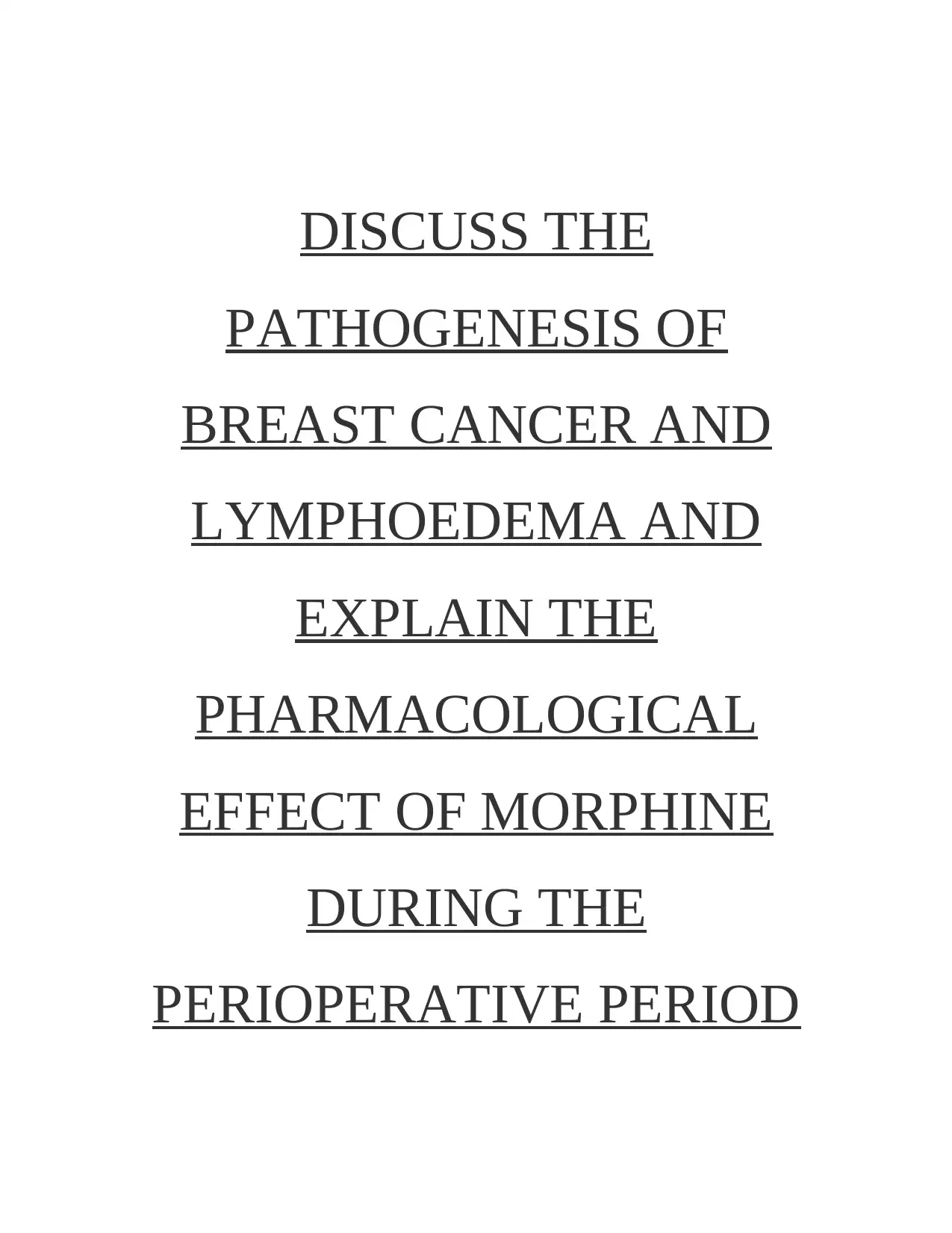
DISCUSS THE
PATHOGENESIS OF
BREAST CANCER AND
LYMPHOEDEMA AND
EXPLAIN THE
PHARMACOLOGICAL
EFFECT OF MORPHINE
DURING THE
PERIOPERATIVE PERIOD
PATHOGENESIS OF
BREAST CANCER AND
LYMPHOEDEMA AND
EXPLAIN THE
PHARMACOLOGICAL
EFFECT OF MORPHINE
DURING THE
PERIOPERATIVE PERIOD
Paraphrase This Document
Need a fresh take? Get an instant paraphrase of this document with our AI Paraphraser

Table of Contents
MAIN BODY...................................................................................................................................3
QUESTION 1...................................................................................................................................1
Explain the pathogenesis of invasive ductal breast carcinoma....................................................1
QUESTION 2...................................................................................................................................2
How the administration of Morphine alters the conscious perception of pain?...........................2
QUESTION 3...................................................................................................................................3
3. Pathogenesis of Lymphoedema that may occur for women who have undergone axillary
lymph node removal during breast cancer surgery......................................................................3
REFERENCES................................................................................................................................4
MAIN BODY...................................................................................................................................3
QUESTION 1...................................................................................................................................1
Explain the pathogenesis of invasive ductal breast carcinoma....................................................1
QUESTION 2...................................................................................................................................2
How the administration of Morphine alters the conscious perception of pain?...........................2
QUESTION 3...................................................................................................................................3
3. Pathogenesis of Lymphoedema that may occur for women who have undergone axillary
lymph node removal during breast cancer surgery......................................................................3
REFERENCES................................................................................................................................4
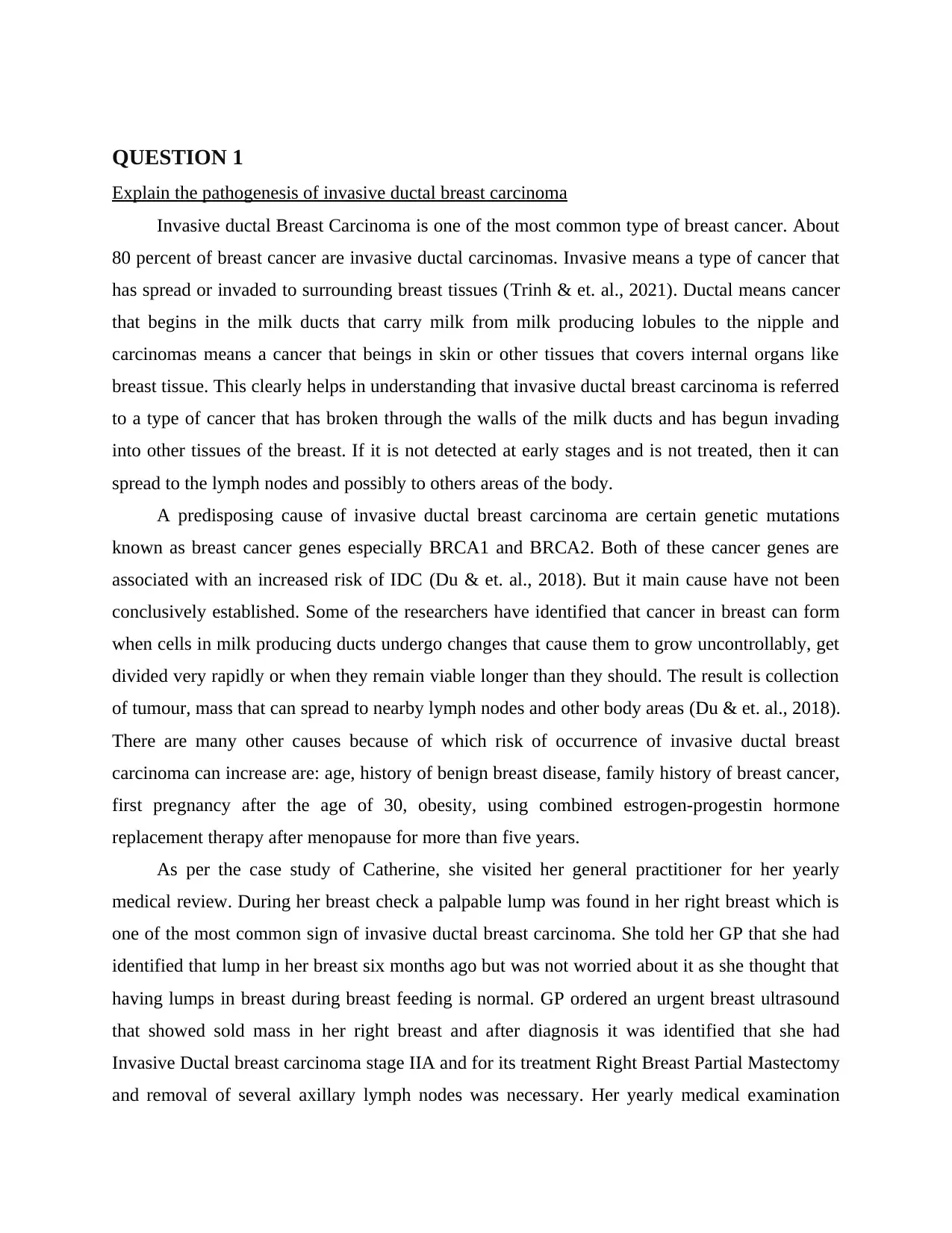
QUESTION 1
Explain the pathogenesis of invasive ductal breast carcinoma
Invasive ductal Breast Carcinoma is one of the most common type of breast cancer. About
80 percent of breast cancer are invasive ductal carcinomas. Invasive means a type of cancer that
has spread or invaded to surrounding breast tissues (Trinh & et. al., 2021). Ductal means cancer
that begins in the milk ducts that carry milk from milk producing lobules to the nipple and
carcinomas means a cancer that beings in skin or other tissues that covers internal organs like
breast tissue. This clearly helps in understanding that invasive ductal breast carcinoma is referred
to a type of cancer that has broken through the walls of the milk ducts and has begun invading
into other tissues of the breast. If it is not detected at early stages and is not treated, then it can
spread to the lymph nodes and possibly to others areas of the body.
A predisposing cause of invasive ductal breast carcinoma are certain genetic mutations
known as breast cancer genes especially BRCA1 and BRCA2. Both of these cancer genes are
associated with an increased risk of IDC (Du & et. al., 2018). But it main cause have not been
conclusively established. Some of the researchers have identified that cancer in breast can form
when cells in milk producing ducts undergo changes that cause them to grow uncontrollably, get
divided very rapidly or when they remain viable longer than they should. The result is collection
of tumour, mass that can spread to nearby lymph nodes and other body areas (Du & et. al., 2018).
There are many other causes because of which risk of occurrence of invasive ductal breast
carcinoma can increase are: age, history of benign breast disease, family history of breast cancer,
first pregnancy after the age of 30, obesity, using combined estrogen-progestin hormone
replacement therapy after menopause for more than five years.
As per the case study of Catherine, she visited her general practitioner for her yearly
medical review. During her breast check a palpable lump was found in her right breast which is
one of the most common sign of invasive ductal breast carcinoma. She told her GP that she had
identified that lump in her breast six months ago but was not worried about it as she thought that
having lumps in breast during breast feeding is normal. GP ordered an urgent breast ultrasound
that showed sold mass in her right breast and after diagnosis it was identified that she had
Invasive Ductal breast carcinoma stage IIA and for its treatment Right Breast Partial Mastectomy
and removal of several axillary lymph nodes was necessary. Her yearly medical examination
Explain the pathogenesis of invasive ductal breast carcinoma
Invasive ductal Breast Carcinoma is one of the most common type of breast cancer. About
80 percent of breast cancer are invasive ductal carcinomas. Invasive means a type of cancer that
has spread or invaded to surrounding breast tissues (Trinh & et. al., 2021). Ductal means cancer
that begins in the milk ducts that carry milk from milk producing lobules to the nipple and
carcinomas means a cancer that beings in skin or other tissues that covers internal organs like
breast tissue. This clearly helps in understanding that invasive ductal breast carcinoma is referred
to a type of cancer that has broken through the walls of the milk ducts and has begun invading
into other tissues of the breast. If it is not detected at early stages and is not treated, then it can
spread to the lymph nodes and possibly to others areas of the body.
A predisposing cause of invasive ductal breast carcinoma are certain genetic mutations
known as breast cancer genes especially BRCA1 and BRCA2. Both of these cancer genes are
associated with an increased risk of IDC (Du & et. al., 2018). But it main cause have not been
conclusively established. Some of the researchers have identified that cancer in breast can form
when cells in milk producing ducts undergo changes that cause them to grow uncontrollably, get
divided very rapidly or when they remain viable longer than they should. The result is collection
of tumour, mass that can spread to nearby lymph nodes and other body areas (Du & et. al., 2018).
There are many other causes because of which risk of occurrence of invasive ductal breast
carcinoma can increase are: age, history of benign breast disease, family history of breast cancer,
first pregnancy after the age of 30, obesity, using combined estrogen-progestin hormone
replacement therapy after menopause for more than five years.
As per the case study of Catherine, she visited her general practitioner for her yearly
medical review. During her breast check a palpable lump was found in her right breast which is
one of the most common sign of invasive ductal breast carcinoma. She told her GP that she had
identified that lump in her breast six months ago but was not worried about it as she thought that
having lumps in breast during breast feeding is normal. GP ordered an urgent breast ultrasound
that showed sold mass in her right breast and after diagnosis it was identified that she had
Invasive Ductal breast carcinoma stage IIA and for its treatment Right Breast Partial Mastectomy
and removal of several axillary lymph nodes was necessary. Her yearly medical examination
⊘ This is a preview!⊘
Do you want full access?
Subscribe today to unlock all pages.

Trusted by 1+ million students worldwide
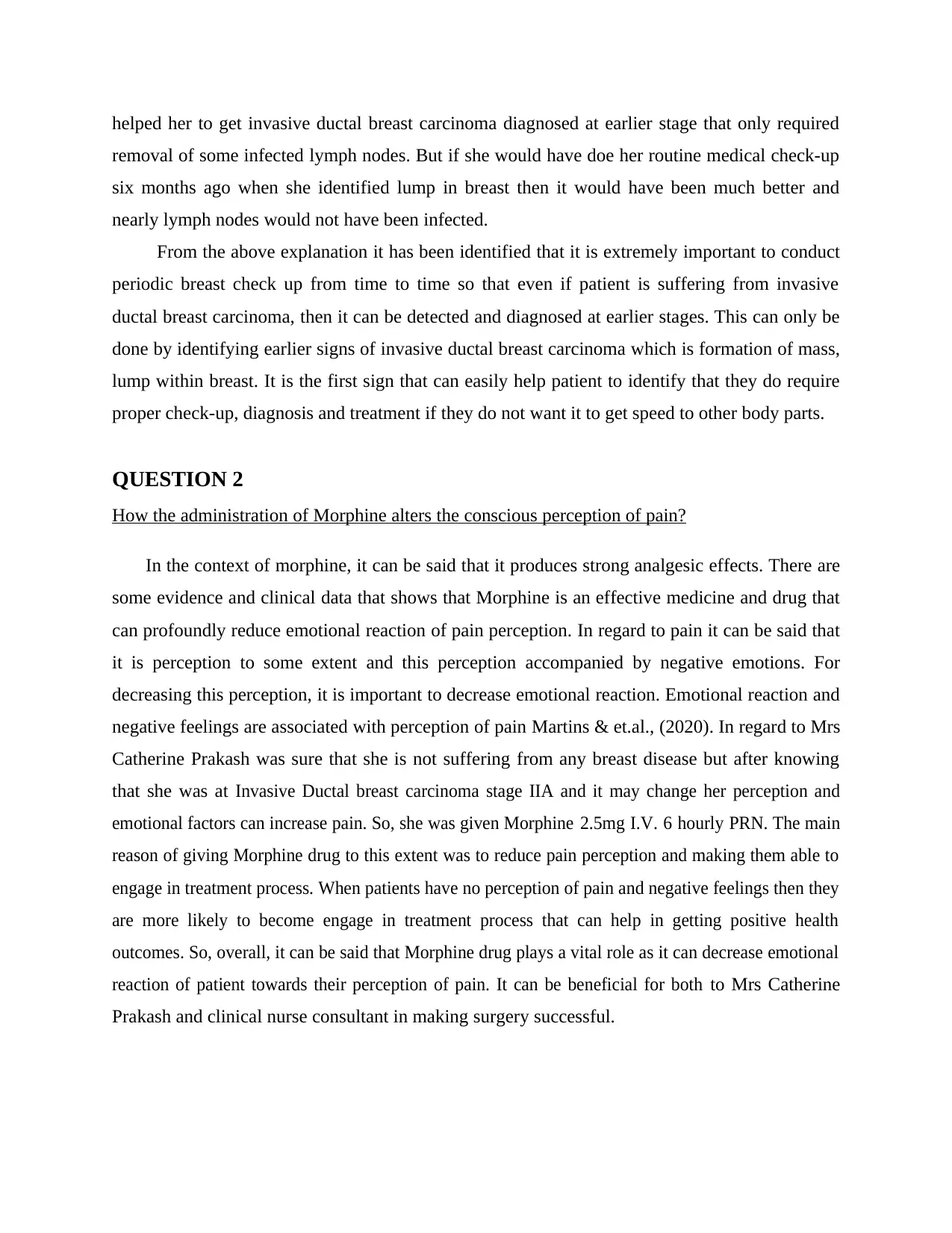
helped her to get invasive ductal breast carcinoma diagnosed at earlier stage that only required
removal of some infected lymph nodes. But if she would have doe her routine medical check-up
six months ago when she identified lump in breast then it would have been much better and
nearly lymph nodes would not have been infected.
From the above explanation it has been identified that it is extremely important to conduct
periodic breast check up from time to time so that even if patient is suffering from invasive
ductal breast carcinoma, then it can be detected and diagnosed at earlier stages. This can only be
done by identifying earlier signs of invasive ductal breast carcinoma which is formation of mass,
lump within breast. It is the first sign that can easily help patient to identify that they do require
proper check-up, diagnosis and treatment if they do not want it to get speed to other body parts.
QUESTION 2
How the administration of Morphine alters the conscious perception of pain?
In the context of morphine, it can be said that it produces strong analgesic effects. There are
some evidence and clinical data that shows that Morphine is an effective medicine and drug that
can profoundly reduce emotional reaction of pain perception. In regard to pain it can be said that
it is perception to some extent and this perception accompanied by negative emotions. For
decreasing this perception, it is important to decrease emotional reaction. Emotional reaction and
negative feelings are associated with perception of pain Martins & et.al., (2020). In regard to Mrs
Catherine Prakash was sure that she is not suffering from any breast disease but after knowing
that she was at Invasive Ductal breast carcinoma stage IIA and it may change her perception and
emotional factors can increase pain. So, she was given Morphine 2.5mg I.V. 6 hourly PRN. The main
reason of giving Morphine drug to this extent was to reduce pain perception and making them able to
engage in treatment process. When patients have no perception of pain and negative feelings then they
are more likely to become engage in treatment process that can help in getting positive health
outcomes. So, overall, it can be said that Morphine drug plays a vital role as it can decrease emotional
reaction of patient towards their perception of pain. It can be beneficial for both to Mrs Catherine
Prakash and clinical nurse consultant in making surgery successful.
removal of some infected lymph nodes. But if she would have doe her routine medical check-up
six months ago when she identified lump in breast then it would have been much better and
nearly lymph nodes would not have been infected.
From the above explanation it has been identified that it is extremely important to conduct
periodic breast check up from time to time so that even if patient is suffering from invasive
ductal breast carcinoma, then it can be detected and diagnosed at earlier stages. This can only be
done by identifying earlier signs of invasive ductal breast carcinoma which is formation of mass,
lump within breast. It is the first sign that can easily help patient to identify that they do require
proper check-up, diagnosis and treatment if they do not want it to get speed to other body parts.
QUESTION 2
How the administration of Morphine alters the conscious perception of pain?
In the context of morphine, it can be said that it produces strong analgesic effects. There are
some evidence and clinical data that shows that Morphine is an effective medicine and drug that
can profoundly reduce emotional reaction of pain perception. In regard to pain it can be said that
it is perception to some extent and this perception accompanied by negative emotions. For
decreasing this perception, it is important to decrease emotional reaction. Emotional reaction and
negative feelings are associated with perception of pain Martins & et.al., (2020). In regard to Mrs
Catherine Prakash was sure that she is not suffering from any breast disease but after knowing
that she was at Invasive Ductal breast carcinoma stage IIA and it may change her perception and
emotional factors can increase pain. So, she was given Morphine 2.5mg I.V. 6 hourly PRN. The main
reason of giving Morphine drug to this extent was to reduce pain perception and making them able to
engage in treatment process. When patients have no perception of pain and negative feelings then they
are more likely to become engage in treatment process that can help in getting positive health
outcomes. So, overall, it can be said that Morphine drug plays a vital role as it can decrease emotional
reaction of patient towards their perception of pain. It can be beneficial for both to Mrs Catherine
Prakash and clinical nurse consultant in making surgery successful.
Paraphrase This Document
Need a fresh take? Get an instant paraphrase of this document with our AI Paraphraser
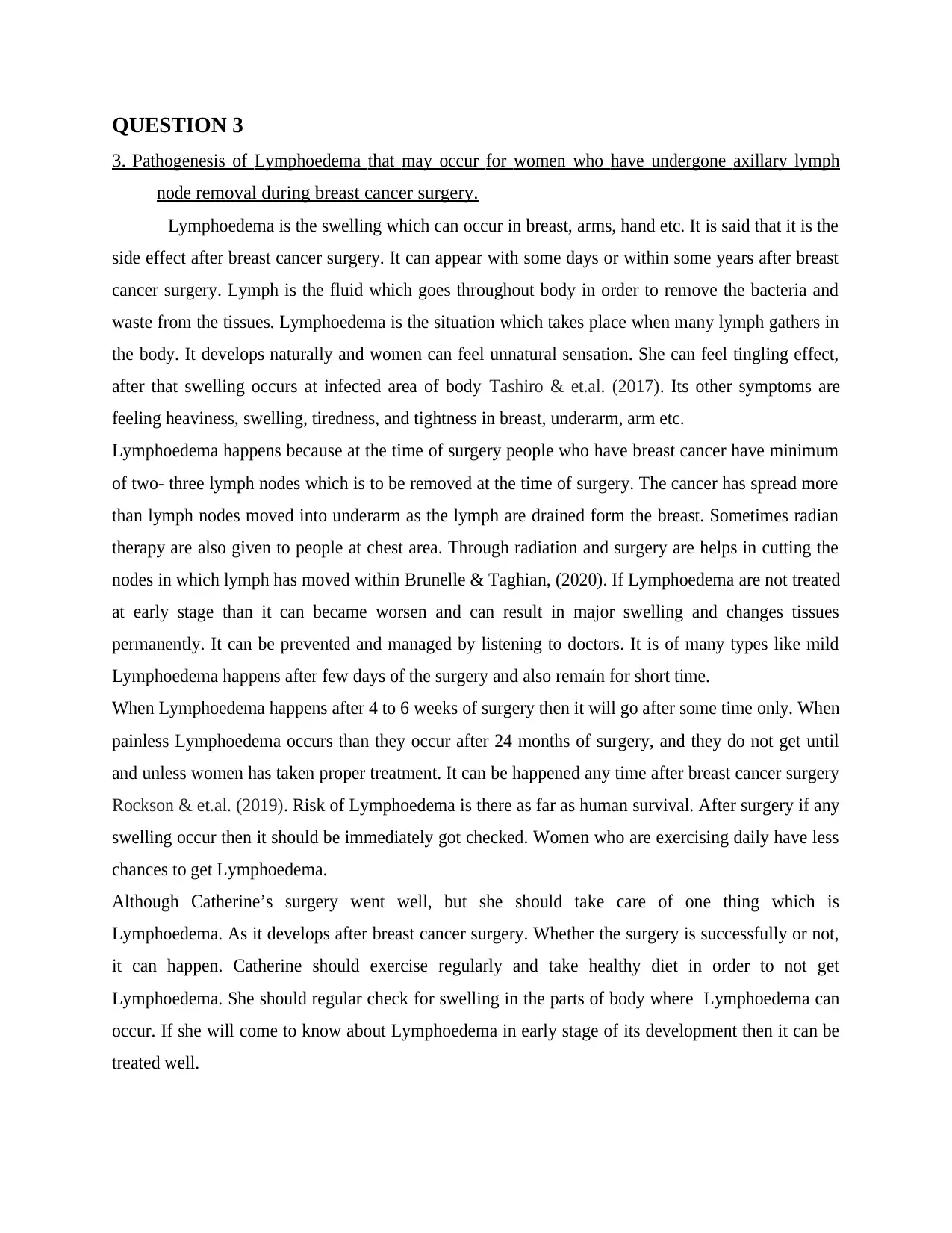
QUESTION 3
3. Pathogenesis of Lymphoedema that may occur for women who have undergone axillary lymph
node removal during breast cancer surgery.
Lymphoedema is the swelling which can occur in breast, arms, hand etc. It is said that it is the
side effect after breast cancer surgery. It can appear with some days or within some years after breast
cancer surgery. Lymph is the fluid which goes throughout body in order to remove the bacteria and
waste from the tissues. Lymphoedema is the situation which takes place when many lymph gathers in
the body. It develops naturally and women can feel unnatural sensation. She can feel tingling effect,
after that swelling occurs at infected area of body Tashiro & et.al. (2017). Its other symptoms are
feeling heaviness, swelling, tiredness, and tightness in breast, underarm, arm etc.
Lymphoedema happens because at the time of surgery people who have breast cancer have minimum
of two- three lymph nodes which is to be removed at the time of surgery. The cancer has spread more
than lymph nodes moved into underarm as the lymph are drained form the breast. Sometimes radian
therapy are also given to people at chest area. Through radiation and surgery are helps in cutting the
nodes in which lymph has moved within Brunelle & Taghian, (2020). If Lymphoedema are not treated
at early stage than it can became worsen and can result in major swelling and changes tissues
permanently. It can be prevented and managed by listening to doctors. It is of many types like mild
Lymphoedema happens after few days of the surgery and also remain for short time.
When Lymphoedema happens after 4 to 6 weeks of surgery then it will go after some time only. When
painless Lymphoedema occurs than they occur after 24 months of surgery, and they do not get until
and unless women has taken proper treatment. It can be happened any time after breast cancer surgery
Rockson & et.al. (2019). Risk of Lymphoedema is there as far as human survival. After surgery if any
swelling occur then it should be immediately got checked. Women who are exercising daily have less
chances to get Lymphoedema.
Although Catherine’s surgery went well, but she should take care of one thing which is
Lymphoedema. As it develops after breast cancer surgery. Whether the surgery is successfully or not,
it can happen. Catherine should exercise regularly and take healthy diet in order to not get
Lymphoedema. She should regular check for swelling in the parts of body where Lymphoedema can
occur. If she will come to know about Lymphoedema in early stage of its development then it can be
treated well.
3. Pathogenesis of Lymphoedema that may occur for women who have undergone axillary lymph
node removal during breast cancer surgery.
Lymphoedema is the swelling which can occur in breast, arms, hand etc. It is said that it is the
side effect after breast cancer surgery. It can appear with some days or within some years after breast
cancer surgery. Lymph is the fluid which goes throughout body in order to remove the bacteria and
waste from the tissues. Lymphoedema is the situation which takes place when many lymph gathers in
the body. It develops naturally and women can feel unnatural sensation. She can feel tingling effect,
after that swelling occurs at infected area of body Tashiro & et.al. (2017). Its other symptoms are
feeling heaviness, swelling, tiredness, and tightness in breast, underarm, arm etc.
Lymphoedema happens because at the time of surgery people who have breast cancer have minimum
of two- three lymph nodes which is to be removed at the time of surgery. The cancer has spread more
than lymph nodes moved into underarm as the lymph are drained form the breast. Sometimes radian
therapy are also given to people at chest area. Through radiation and surgery are helps in cutting the
nodes in which lymph has moved within Brunelle & Taghian, (2020). If Lymphoedema are not treated
at early stage than it can became worsen and can result in major swelling and changes tissues
permanently. It can be prevented and managed by listening to doctors. It is of many types like mild
Lymphoedema happens after few days of the surgery and also remain for short time.
When Lymphoedema happens after 4 to 6 weeks of surgery then it will go after some time only. When
painless Lymphoedema occurs than they occur after 24 months of surgery, and they do not get until
and unless women has taken proper treatment. It can be happened any time after breast cancer surgery
Rockson & et.al. (2019). Risk of Lymphoedema is there as far as human survival. After surgery if any
swelling occur then it should be immediately got checked. Women who are exercising daily have less
chances to get Lymphoedema.
Although Catherine’s surgery went well, but she should take care of one thing which is
Lymphoedema. As it develops after breast cancer surgery. Whether the surgery is successfully or not,
it can happen. Catherine should exercise regularly and take healthy diet in order to not get
Lymphoedema. She should regular check for swelling in the parts of body where Lymphoedema can
occur. If she will come to know about Lymphoedema in early stage of its development then it can be
treated well.
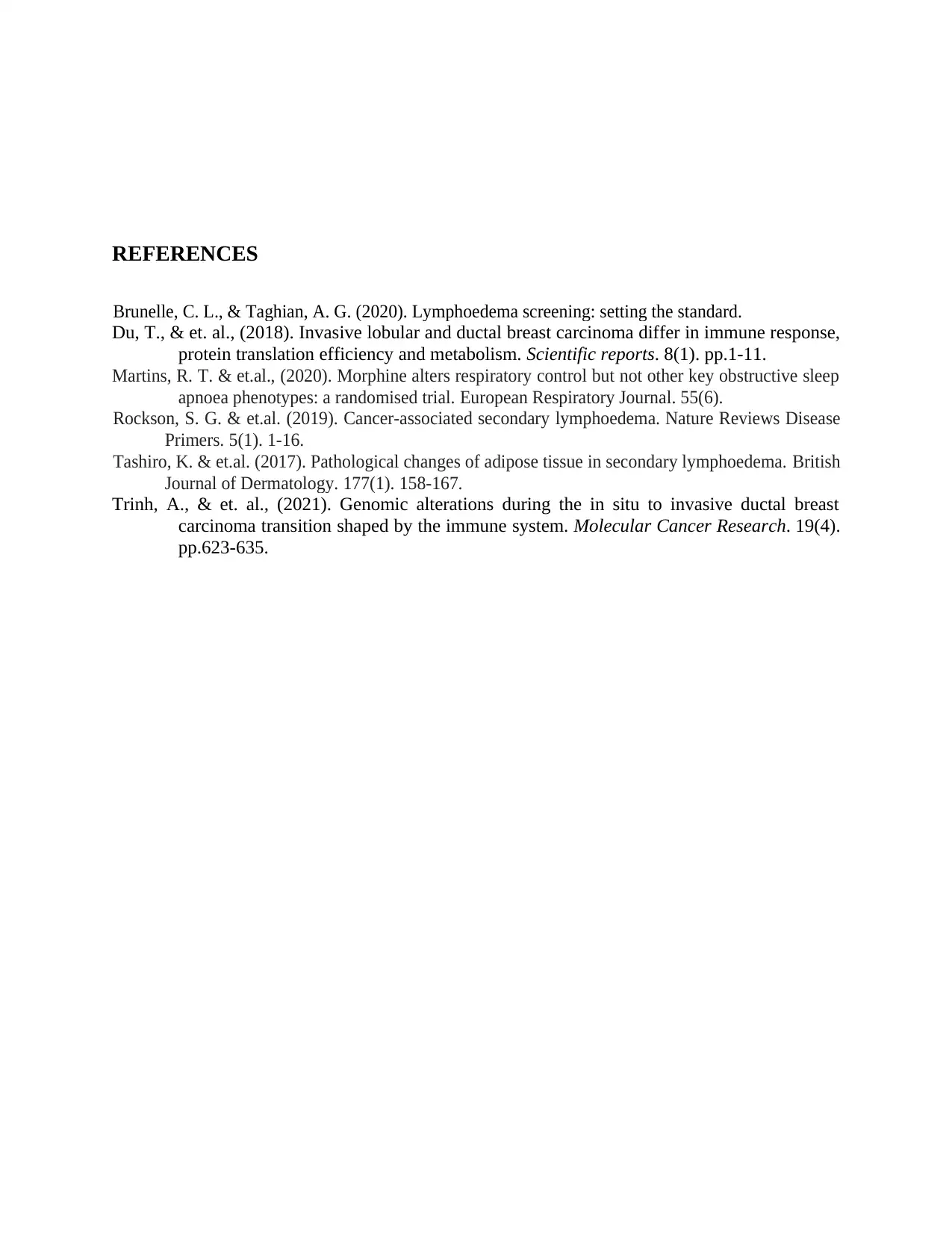
REFERENCES
Brunelle, C. L., & Taghian, A. G. (2020). Lymphoedema screening: setting the standard.
Du, T., & et. al., (2018). Invasive lobular and ductal breast carcinoma differ in immune response,
protein translation efficiency and metabolism. Scientific reports. 8(1). pp.1-11.
Martins, R. T. & et.al., (2020). Morphine alters respiratory control but not other key obstructive sleep
apnoea phenotypes: a randomised trial. European Respiratory Journal. 55(6).
Rockson, S. G. & et.al. (2019). Cancer-associated secondary lymphoedema. Nature Reviews Disease
Primers. 5(1). 1-16.
Tashiro, K. & et.al. (2017). Pathological changes of adipose tissue in secondary lymphoedema. British
Journal of Dermatology. 177(1). 158-167.
Trinh, A., & et. al., (2021). Genomic alterations during the in situ to invasive ductal breast
carcinoma transition shaped by the immune system. Molecular Cancer Research. 19(4).
pp.623-635.
Brunelle, C. L., & Taghian, A. G. (2020). Lymphoedema screening: setting the standard.
Du, T., & et. al., (2018). Invasive lobular and ductal breast carcinoma differ in immune response,
protein translation efficiency and metabolism. Scientific reports. 8(1). pp.1-11.
Martins, R. T. & et.al., (2020). Morphine alters respiratory control but not other key obstructive sleep
apnoea phenotypes: a randomised trial. European Respiratory Journal. 55(6).
Rockson, S. G. & et.al. (2019). Cancer-associated secondary lymphoedema. Nature Reviews Disease
Primers. 5(1). 1-16.
Tashiro, K. & et.al. (2017). Pathological changes of adipose tissue in secondary lymphoedema. British
Journal of Dermatology. 177(1). 158-167.
Trinh, A., & et. al., (2021). Genomic alterations during the in situ to invasive ductal breast
carcinoma transition shaped by the immune system. Molecular Cancer Research. 19(4).
pp.623-635.
⊘ This is a preview!⊘
Do you want full access?
Subscribe today to unlock all pages.

Trusted by 1+ million students worldwide
1 out of 6
Related Documents
Your All-in-One AI-Powered Toolkit for Academic Success.
+13062052269
info@desklib.com
Available 24*7 on WhatsApp / Email
![[object Object]](/_next/static/media/star-bottom.7253800d.svg)
Unlock your academic potential
Copyright © 2020–2025 A2Z Services. All Rights Reserved. Developed and managed by ZUCOL.





